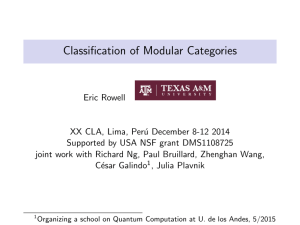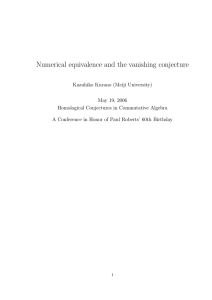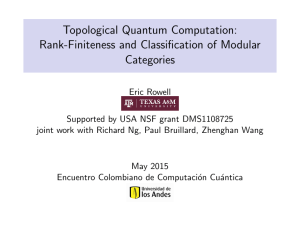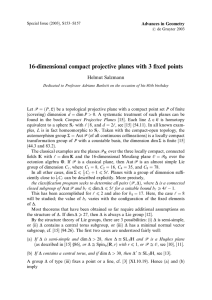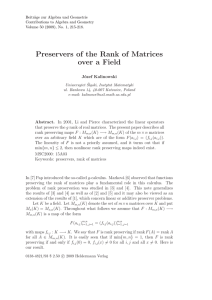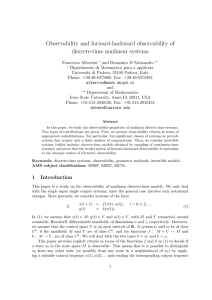Classification of Modular Categories
advertisement
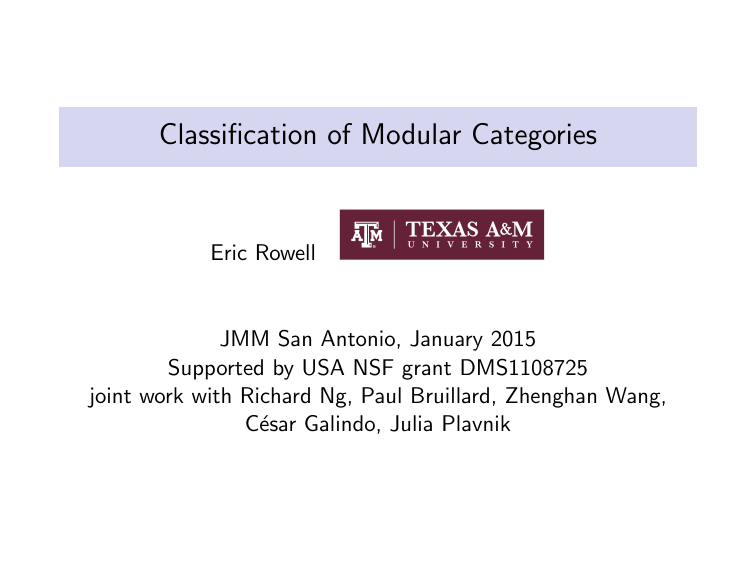
Classification of Modular Categories
Eric Rowell
JMM San Antonio, January 2015
Supported by USA NSF grant DMS1108725
joint work with Richard Ng, Paul Bruillard, Zhenghan Wang,
César Galindo, Julia Plavnik
Definition
A modular category C (over C) is
monoidal: (⊗, 1), L
semisimple: X ∼
= i mi Xi ,
linear: Hom(X , Y ) ∈ VecC ,
rigid: X ∗ ⊗ X 7→ 1 7→ X ⊗ X ∗ ,
finite rank: Irr(C) = {1 = X0 , . . . , Xr −1 },
spherical: uX θX : X ∼
= X ∗∗ , dim(X ) ∈ R,
braided: cX ,Y : X ⊗ Y ∼
= Y ⊗ X,
modular: det(TrC (cXi ,Xj∗ cXj∗ ,Xi )) 6= 0.
Remark
I
uX is Drinfeld isomorphism, θ is ribbon structure, satisfying,
e.g.: θX ⊗Y = θX ⊗ θY (cY ,X cX ,Y )
I
TrC : End(X ) → C is the pivotal trace.
Key Data
I
I
L
fusion rules: Xi ⊗ Xj ∼
= k Nijk Xk
(modular) S-matrix: Sij := TrC (cXi ,Xj∗ cXj∗ ,Xi )
I
(Dehn twist) T -matrix: Tij = δij θi
I
(congruence subgroup) Level: N = ord(T )
I
(quantum) Dimensions: di := Si0 and dim(C) :=
I
Ambient fields: Q(S) := Q(Sij ) and Q(T ) := Q(θi ).
I
(Dedekind domain) Ring of integers: OQ(T ) = Z[ζN ].
Pr −1
i=0
di2
I
Definition (In Coordinates)
For S, T ∈ C(r ,r ) define dj := S0j , θj := Tjj , D 2 :=
P
p± := j dj2 θj±1 . (S, T ) admissible if:
P
j
dj2 ,
t
1. S = S t , SS = D 2 Id, T diagonal, ord(T ) = N < ∞
N
=1
2. (ST )3 = p+ S 2 , p+ p− = D 2 , pp−+
P
S
S
S
ia
ja
ka
3. Nijk := a D 2 da ∈ N
P
4. θi θj Sij = a Nik∗ j dk θk where Nii0∗ uniquely defines i ∗ .
n
P
5. νn (k) := D12 i,j Nijk di dj θθji
∈ Z[ζN ] satisfies:
ν2 (k) ∈ {0, ±1}
6. Q(S) ⊂ Q(T ), AutQ Q(S) ⊂ Sr , AutQ(S) Q(T ) ∼
= (Z2 )k .
2
7. Prime (ideal) divisors of hD i and hNi coincide in Z[ζN ].
Conjecture: Any admissible (S, T ) determines a modular category.
Sources
I
Pointed : C(A, q), A finite abelian group, q non-degenerate
quad. form on A.
I
Group-theoretical: D ⊂ Rep(D ω G ), ω a 3-cocycle on G a
finite group.
Quantum groups/Kac-Moody algebras: subquotients of
Rep(Uq g) at q = e πi/` or level k integrable ĝ-modules. e.g.
I
I
I
I
I
I
SU(N)k = C(slN , N + k),
SO(N)k ,
Sp(N)k ,
for gcd(N, k) = 1, PSU(N)k ⊂ SU(N)k “even half”
Drinfeld center: Z(D) for spherical fusion category D.
Example
SU(2)`−2 from Rep(Uq sl2 ) at q = e πi/`
I
simple objects {X0 = 1, X1 , . . . , X`−2 }
I
Sij =
I
X1 ⊗ Xk ∼
= Xk−1 ⊕ Xk+1 for 1 ≤ k ≤ ` − 3
I
θj = e
I
sin(
(i+1)(j+1)π
)
`
sin( π` )
πi(j 2 +2j)
2`
so ord(T ) = 4`
P
2
D 2 = dim SU(2)`−2 = `−1
n=1 [n] where [n] =
q n −q −n
.
q−q −1
Tambara Yamagami Categories
Definition
C is weakly integral if dim(C) ∈ N.
Example
Let A be a finite abelian group, χ a non-degenerate bicharacter on
A and ν a sign. Tambara and Yamagami defined a spherical fusion
category TY (A, χ, ν) with simple objects A ∪ {m} with:
P
I m⊗m =
a∈A a
I
m⊗a=m
I
a ⊗ b = ab
dim(TY (A, χ, ν)) = 2|A|. ZTY (A, χ, ν) is modular.
For the rest of this talk, we assume dim(X ) > 0 for all X .
Problem
Classify “small” modular categories.
E.g.:
I
Bounded rank: r < M,
I
few primes: |{p : p | dim(C)}| < M. For p ∈ Z, stay for
Naidu’s talk
I
Bounded level: ord(T ) < M
Rank-Finiteness
Theorem (Bruillard,Ng,R,Wang 2013)
There are finitely many modular categories of a given rank r .
History:
I
(2003) Conjectured by Wang, verified for rank = 2 (Ostrik).
I
(2005) Verified for: fusion categories with dim(C) ∈ N
(Etingof, Nikshych and Ostrik), rank= 3 (Ostrik).
I
(2009-10) Verified for: rank = 4 (R,Stong,Wang), rank = 5
non-self-dual (R,Hong).
Warm Up
Theorem (E. Landau 1903)
For any r ∈ N, there are finitely many groups G with |Irr (G )| = r .
Proof.
Use class equation:
|G | =
r
X
|gi |,
i=1
gi distinct conjugacy classes. Set xi = [G : C (gi )] (index of
centralizers) to get
r
X
1
1=
.
xi
i=1
xi ≤ a(r ) where a(1) = 2, a(2) = 3, a(n) = a(n − 1)a(n − 2) + 1 is
Sylvester’s sequence. Therefore |G | = maxi xi is bounded. So
finitely many multiplication tables.
Key Steps
Proof.
1. By [R,Stong,Wang ’08] enough to bound dim(C).
2. By [Evertse ’84] enough to bound
[
{p ∈ Spec Z[ζN ] : p|hdim(C)i}
rank(C)=r
3. By Cauchy Theorem [Bruillard,Ng,R.,Wang] enough to bound
Mr := max{N = ord(T ) : rank(C) = r }.
4. By [Ng,Schauenburg ’10] Mr bounded.
Some Details
I
I
Congruence Subgroup Property: gives bound on Mr
I
Cauchy: prime divisors of hdim(C)i and hNi in Z[ζN ] coincide.
I
Evertse: finite number of non-degenerate solutions to
0 = 1 + x0 + · · · + xr −1 where xi are S-units for any finite set
of primes S. Notice: 0 = 1 − dim(C) + d1 + · · · + dr −1 , so
dim(C) bounded!
Example (C = SU(2)3 )
N = ord(T ) = 20 and dim(C) = 5 +
√
I
I
h5 + 5i = h2ih1 − (ζ20 )4 i2
h20i = h2i2 h1 − (ζ20 )4 i4
√
5. In Z[ζ20 ],
Low Rank Modular Categories
Theorem (R,Hong,Stong,Bruillard,Ng,Wang,Ostrik)
If 2 ≤ rank(C) ≤ 5 then C has the same fusion rules as one of:
I
PSU(2)3 (Fibonacci), SU(2)1 (pointed)
I
PSU(2)5 , SU(2)2 (Ising), SU(3)1 (pointed)
I
PSU(2)7 , SU(2)3 , SU(4)1 , products.
I
SU(2)4 , PSU(2)9 , SU(5)1 , PSU(3)4 .
Theorem (R,Bruillard)
I
Suppose C has ord(T ) ∈ {2, 3, 4}. Then C ⊂ Rep(D ω G ) for
some 2- or 3-group G .
I
Suppose dim(C) is odd and rank(C) ≤ 11. Then C is pointed.
Remark
I
ord(T ) = 6 implies integral, but not C ⊂ Rep(D ω G ).
I
Open: dim(C) odd, 13 ≤ rank(C) ≤ 23 implies pointed?
I
Open: dim(C) odd implies group-theoretical?
Theorem (R,Ng,Bruillard,Wang,Galindo,Plavnik)
If C is:
I
weakly integral with rank(C) ≤ 7 or
dim(C) = 4m with m odd and square-free
∼ D F where D, F ⊂ ZTY (A, χ, ν).
then C =
I
More explicitly: D, F are pointed, Ising or TY (Z2k+1 , χ, ν)Z2 .
Lemma
Suppose C is weakly integral modular category with exactly one
simple (class) X with dim(X ) 6∈ Z. Then C is an Ising category.
Problem
dim(X ) ∈ Z for all X implies C ≡ Rep(H), H quasi-Hopf. What
about dim(C) ∈ Z?
Thank you!
Based on arXiv: 1310.7050 and 1411.2313
